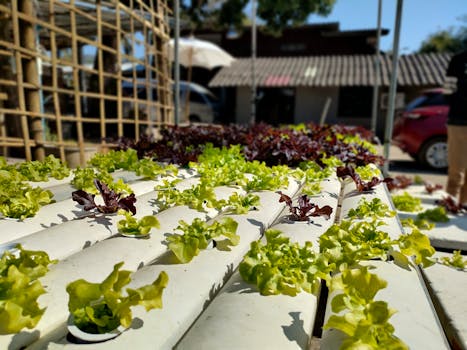Anúncios
Building agriculture systems requires an understanding of not just soil and crops, but also the broader context of environmental sustainability, economic viability, and community involvement.
As the demand for food continues to rise, innovative and efficient agricultural practices become ever more crucial. This article outlines effective methods to establish sustainable agriculture systems.
Through careful planning and execution, stakeholders in agriculture can create resilient systems that adapt to changing climates and evolving market needs. Let’s explore how to build these agriculture systems.
Defining Your Agriculture Goals
Before any system is established, it’s vital to set clear agriculture goals. Decide what type of food or products you wish to produce.
This step requires identifying both short-term and long-term objectives. Think about quality, quantity, and sustainability in your goals.
Anúncios
It’s important to engage stakeholders, such as farmers and local businesses, in this process. Their insights can inform and refine your goals significantly.
Additionally, take into account the needs of your community and market trends. This ensures that your agriculture system meets real-world demands.
Finally, remember that flexibility is key. As circumstances change, so should your goals, allowing for continual improvement and adaptation.
Anúncios
Understanding Soil Health
A foundational aspect of any agriculture system is soil health. Healthy soil enhances plant growth and increases resilience against pests.
Implement soil testing programs periodically. This assessment reveals the nutrient composition and pH balance of your soil, guiding necessary amendments.
Utilizing organic matter, such as compost or cover crops, can significantly improve soil health. These additions help to retain moisture and nutrients.
Practicing crop rotation is another effective strategy. This avoids nutrient depletion and reduces pest and disease buildup.
Finally, consider employing no-till or reduced-till techniques to preserve soil structure. Healthy soil systems lead to enhanced productivity and sustainability.
Water Management Practices
Water management is crucial to sustainable agriculture systems. Efficient irrigation practices ensure crops receive adequate water without wastage.
Methods like drip irrigation deliver water directly to the roots. This reduces water use and minimizes evaporation losses.
Rainwater harvesting can also be an effective way to supplement water supplies. Collecting runoff can ensure crops remain hydrated during dry spells.
Implementing moisture sensors can provide real-time data on soil moisture levels. This technology helps farmers apply water more efficiently.
Incorporating drought-resistant crop varieties can further alleviate water concerns. This practice diversifies risks and ensures productivity in varying conditions.
Crop Selection and Diversity
Choosing the right crops is fundamental to building a sustainable agriculture system. Assess local environmental conditions and market demands before selection.
Diverse cropping systems can enhance resilience. Growing a variety of crops reduces the risk of complete failure due to pests or disease.
Consider incorporating perennial crops into your system. They contribute to soil health and require less maintenance compared to annuals.
It’s also wise to pay attention to the growing season. Select crops based on their suitability for your local climate and growing conditions.
Lastly, staying informed about new crop varieties and technologies will enhance your agricultural productivity and sustainability over time.
Integrating Livestock in Agriculture Systems
Integrating livestock into agricultural systems can provide various benefits. They contribute to nutrient cycling and can help manage land efficiently.
Consider pasture-raised systems that allow livestock to graze. This practice often results in healthier animals and more nutrient-rich products.
Additionally, implementing agroforestry practices can create a productive environment. Trees provide shade, improve soil health, and increase biodiversity.
Utilizing livestock waste as fertilizer can reduce costs while enhancing soil nutrients. This circular approach to farming promotes sustainability.
Lastly, ensure to maintain animal welfare standards. Healthy animals produce better yields, leading to a more successful agricultural enterprise.
Utilizing Technology in Agriculture
Technology plays an important role in modern agriculture systems. Precision agriculture, for instance, allows for optimal inputs and resource management.
Using GPS-guided equipment can enhance efficiency in planting and harvesting. This technology helps reduce manual labor and improves productivity.
Drones and satellite imaging are valuable for monitoring crop health. These tools can provide insights that inform timely interventions.
Employing data analytics can further enhance decision-making. By analyzing trends, farmers can improve crop yields and operational efficiency.
Finally, don’t overlook the potential benefits of mobile applications. They can assist with everything from farm management to market pricing data.
Community Engagement and Education
Building agriculture systems requires collaboration with local communities. Engage community members from the beginning to encourage ownership and investment.
Develop educational programs to share best practices. Workshops, farm tours, and online resources can enhance community knowledge.
Create partnerships with local schools or universities. These collaborations can offer innovative solutions and engage future generations in agriculture.
Encourage farmers’ markets to promote local produce. This strengthens community ties and provides economic opportunities for local farmers.
Lastly, establish a feedback loop. Continuous interaction with community members helps in assessing the impact and adapting agriculture systems over time.
Conclusão
Building effective agriculture systems is a multifaceted effort that encompasses various elements. From setting clear goals to integrating technology and engaging the community, every step contributes to sustainability.
By focusing on soil health, water management, and crop diversity, stakeholders can create resilient agriculture systems. Furthermore, embracing technology will streamline operations and improve productivity.
Ultimately, collaborative efforts and continuous education are essential for the success of these initiatives. Together, we can build agriculture systems that are not only productive but also sustainable.
| Element | Description | Beneficiar |
|---|---|---|
| Soil Health | Caring for soil’s nutrient balance | Improved crop yields |
| Water Management | Efficient irrigation and conservation | Reduced water usage |
| Crop Diversity | Growing a variety of crops | Increased resilience |
| Tecnologia | Utilizing modern tools and analytics | Enhanced productivity |
| Community Engagement | Involving community in agriculture practices | Stronger local support |
- Set clear agriculture goals.
- Maintain soil health through organic practices.
- Implement efficient water management systems.
- Choose a variety of crops for resilience.
- Use technology to enhance farming practices.
- Engage community members actively.



